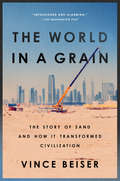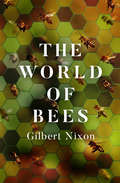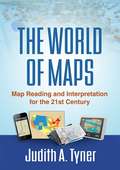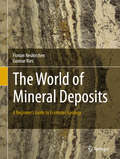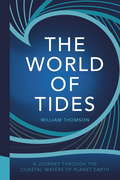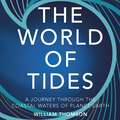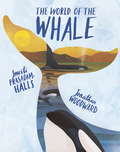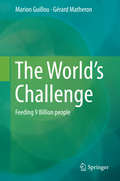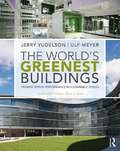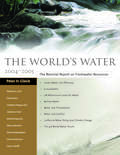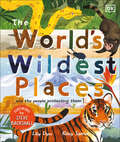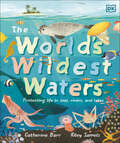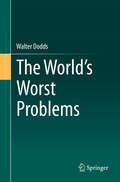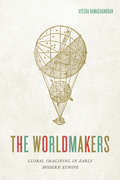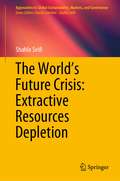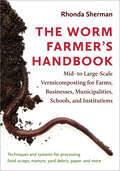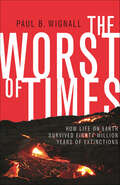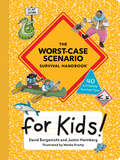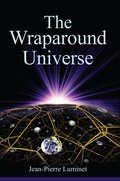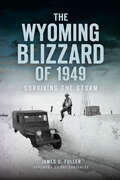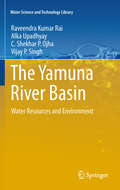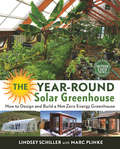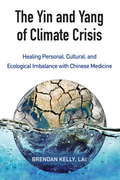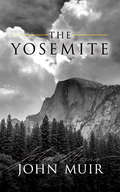- Table View
- List View
The World in a Grain: The Story of Sand and How It Transformed Civilization
by Vince BeiserThe gripping story of the most important overlooked commodity in the world--sand--and the crucial role it plays in our lives.After water and air, sand is the natural resource that we consume more than any other--even more than oil. Every concrete building and paved road on Earth, every computer screen and silicon chip, is made from sand. From Egypt's pyramids to the Hubble telescope, from the world's tallest skyscraper to the sidewalk below it, from Chartres' stained-glass windows to your iPhone, sand shelters us, empowers us, engages us, and inspires us. It's the ingredient that makes possible our cities, our science, our lives--and our future.And, incredibly, we're running out of it.The World in a Grain is the compelling true story of the hugely important and diminishing natural resource that grows more essential every day, and of the people who mine it, sell it, build with it--and sometimes, even kill for it. It's also a provocative examination of the serious human and environmental costs incurred by our dependence on sand, which has received little public attention. Not all sand is created equal: Some of the easiest sand to get to is the least useful. Award-winning journalist Vince Beiser delves deep into this world, taking readers on a journey across the globe, from the United States to remote corners of India, China, and Dubai to explain why sand is so crucial to modern life. Along the way, readers encounter world-changing innovators, island-building entrepreneurs, desert fighters, and murderous sand pirates. The result is an entertaining and eye-opening work, one that is both unexpected and involving, rippling with fascinating detail and filled with surprising characters.
The World of Bees
by Gilbert NixonAn entomologist presents a beautifully illustrated study of bees, from their behavior to social structures, colonies, and relationship to the environment. In this engaging and scholarly volume, entomologist Gilbert Nixon shares his lifelong fascination with bees. Nixon&’s childhood love of these curious insects led to decades of study as he learned to identify their distinctive markings and pursued the secrets of their mystifying behaviors.The World of Bees offers a comprehensive introduction to various species of bees, including honey bees, bumblebees, and leafcutter bees, as well as information on related insects such as botflies and wasps. With color illustrations by Arthur Smith, this expert volume covers all major topics in melittology, including mating habits, life cycles, pollination, bee dances, and more.
The World of Maps
by Judith A. TynerMaps have power--they can instruct, make life easier, mislead, or even lie. This engaging text provides the tools to read, analyze, and use any kind of map and assess its strengths and weaknesses. Requiring no advanced math skills, the book presents basic concepts of symbolization, scale, coordinate systems, and projections. It gives students a deeper understanding of the types of maps they encounter every day, from turn-by-turn driving directions to the TV weather report. Readers also learn how to use multiple maps and imagery to analyze an area or region. The book includes 168 figures, among them 22 color plates; most of the figures can be downloaded as PowerPoint slides from the companion website. Appendices contain a glossary, recommended resources, a table of commonly used projections, and more.
The World of Mineral Deposits: A Beginner's Guide to Economic Geology
by Florian Neukirchen Gunnar RiesThis vivid introduction to economic geology not only describes the most important deposit types, but also the processes involved in their formation. Magmatic, hydrothermal and sedimentary processes as well as weathering and alteration are explained in the framework of plate tectonics and the history of the Earth. The chapter about fossil fuels includes unconventional deposits and the much-debated fracking. Other topics covered are exploration, mining and economic aspects like commodity prices.
The World of Tides: A Journey Through the Coastal Waters of Planet Earth
by William ThomsonIn The Book of Tides, William Thomson took the reader on a mesmerising journey round the coast of Britain. Now, he sets out with his surfboard and tidal compass to encounter the waters of the world, charting his most extraordinary sights and experiences. These include the whirlpools of the Arctic circle, the world's biggest ever surfed wave off Portugal, the strongest whirlpool in Norway and, in Australia, the most dangerous rapids known to us.With the enticing combination of William's passionate text and collectable mapping illustrations, this is a book for anyone who feels the pull of the tides and call of the sea.FEATURING:New ZealandAustraliaPortugalFranceEnglandScotlandNorwayThe NetherlandsSpainIndonesiaChinaJapanUSACanadaBelize
The World of Tides: A Journey Through the Coastal Waters of Planet Earth
by William ThomsonIn The Book of Tides, William Thomson took the reader on a mesmerising journey round the coast of Britain. Now, he sets out with his surfboard and tidal compass to encounter the waters of the world, charting his most extraordinary sights and experiences. These include the whirlpools of the Arctic circle, the world's biggest ever surfed wave off Portugal, the strongest whirlpool in Norway and, in Australia, the most dangerous rapids known to us.With the enticing combination of William's passionate text and collectible mapping illustrations, this is a book for anyone who feels the pull of the tides and call of the sea.FEATURING:New ZealandAustraliaPortugalFranceEnglandScotlandNorwayThe NetherlandsSpainIndonesiaChinaJapanUSACanadaBelize(P)2017 Quercus Editions Limited
The World of the Whale
by Smriti Prasadam-HallsDive into the underwater world of whales and dolphins in this entrancing illustrated guide. Graceful and serene, intelligent and social, the whale is a wonder of the deep blue sea. And yet, whales rely on air to breathe - they are mammals, just like us.With breathtaking text, Smriti Prasadam-Halls explores the migrations, songs and family life of these mysterious creatures, and reveals the dangers they face from plastic, pollution and hunting. Wildlife illustrator Jonathan Woodward brings the marine world to life with stunning papercut collage artwork. An astonishing follow-up to the English 4-11 Award-winning book The Ways of the Wolf, which is also shortlisted for the SLA Award.'The expressive writing and the colourful, original artwork depict the lives of whales perfectly. Perceptively illustrating their strong social nature and intelligence, this beautiful book also explores the dangers faced by these incredible creatures and the need for us to work together to protect them.' - Whale & Dolphin Conservation
The World's Challenge
by Marion Guillou Gérard MatheronIf a global population of 9 billion by 2050 is to be fed adequately, more food must be produced and this in keeping with increasingly stringent standards of quality and with respect for the environment. Not to mention the land that must be set aside for the production of energy resources, industrial goods, carbon storage and the protection of biodiversity.
The World's Greenest Buildings: Promise Versus Performance in Sustainable Design
by Jerry Yudelson Ulf MeyerThe World’s Greenest Buildings tackles an audacious task. Among the thousands of green buildings out there, which are the best, and how do we know? Authors Jerry Yudelson and Ulf Meyer examined hundreds of the highest-rated large green buildings from around the world and asked their owners to supply one simple thing: actual performance data, to demonstrate their claims to sustainable operations. This pivotal book presents: an overview of the rating systems and shows "best in class" building performance in North America, Europe, the Middle East, India, China, Australia and the Asia-Pacific region practical examples of best practices for greening both new and existing buildings a practical reference for how green buildings actually perform at the highest level, one that takes you step-by-step through many different design solutions a wealth of exemplary case studies of successful green building projects using actual performance data from which to learn interviews with architects, engineers, building owners and developers and industry experts, to provide added insight into the greening process This guide uncovers some of the pitfalls that lie ahead for sustainable design, and points the way toward much faster progress in the decade ahead.
The World's Water 2004-2005: The Biennial Report on Freshwater Resources (The World's Water)
by Peter H. Gleick Pacific Institute Catherine Hunt Dana Haasz Nicholas L. Cain Christine Henges-JeckThe quality and availability of fresh water are of critical importance to human and ecosystem health. Given its central role in the functioning of all living systems, water is arguably the most important of all natural resources. Produced biennially, The World's Water provides a timely examination of the key issues surrounding freshwater resources and their use. Each new volume identifies and explains the most significant current trends worldwide, and offers the best data available on a variety of water-related topics. This 2004-2005 edition of The World's Water features overview chapters on: conservation and efficiency as key tools for meeting freshwater needs; bottled water quality, costs, and trends; United Nations millennium development goals; groundwater issues; case studies of water privatization; the economic value of water; California water policy and climate change. The World's Water is the most comprehensive and up-to-date source of information and analysis on freshwater resources and the political, economic, scientific, and technological issues associated with them. It is an essential reference for water resource professionals in government agencies and nongovernmental organizations, researchers, students, and anyone concerned with water and its use.
The World's Wildest Places: And the People Protecting Them
by Lily DyuDiscover the wildest places on earth, and meet the amazing people dedicating their lives to conserving them.The World&’s Wildest Places engages adventurous and curious children with the action being taken to combat the human impact on Planet Earth. Young readers can embark on the journey of a lifetime to 20 of the world's wildest places! Explore each environment, and learn about the keepers who are working to preserve them for future generations. Meet the animals and plants who call the wilderness home, and discover how you can take active steps to make a difference. Featuring colorful original illustrations and stunning photography, The World's Wildest Places brings the excitement of the jungle and the adventure of the rainforest to your lap.This striking conversation book for kids features: - 20 incredible locations across six continents, from tropical rainforests to deserts.- Combines stunning illustrations and photography to bring the places, people and animals to life.- Accessible text providing young readers with an easy introduction to conservation and the environment.- Hide and Seek / Search and Find activities for every location make reading fun.- Highlights the conservation work that is underway across the globe.This awe-inspiring environment book is the perfect addition to the library of curious 6+ year olds with an interest in animals, adventure and exploration, alongside caregivers seeking to empower children to bring about positive change to the planet. Celebrate your child&’s curiosity as they dive into the wild and wonderful scenes of the world&’s most stunning habitats, with clear and accessible text that offers young readers an entry-point to conservation and the environment. Featuring a foreword by WLT patron and well-known naturalist Steve Backshall, this amazing animal book was developed in collaboration with World Land Trust, a conservation charity protecting the world&’s most threatened habitats.
The World's Wildest Waters: Protecting Life in Seas, Rivers, and Lakes
by Catherine BarrA beautifully presented entry point text about our oceans and other watery worlds for 6 years and upDive into the world&’s wildest oceans, lakes, and rivers, and get ready for an underwater adventure!Embark on the journey of a lifetime to 20 of the world&’s wildest waters! Explore each environment and learn about the people who are working to preserve them for future generations. Meet the creatures who call these watery worlds home and discover how you can take active steps to make a difference. Featuring colorful original illustrations and stunning photography, The World&’s Wildest Waters brings the excitement of the high seas and the mystery of the ocean&’s dark, hidden depths to your lap.
The World's Worst Problems
by Walter DoddsThis book addresses the worst problems currently facing humanity and those that may pose future threats. The problems are explained and approached through a scientific lens, and categorized based on data involving global mortality, vulnerability, and threat level. The book presents indices of problem severity to compare relative intensity of current and potential crises. The approach avoids emotional argument using mainly empirical evidence to support the classification of relative problem severity. The author discusses multiple global problems and ranks them. He also explores specific solutions to each problem, links problems to human behavior from a social science perspective, considers international cooperation, and finally pathways to solutions.The book discusses confirmation bias and why this necessitates a scientific approach to tackle problems. The moral assumption that each person has the same rights to life and minimal suffering, and that the natural world has a right to exist, forms the basis of ranking problems based on death, suffering, and harm to the natural world. A focus is given to potential disasters such as asteroid collisions and super-volcanic eruptions, which are then presented in chapters that address specific contemporary global issues including disease, hunger, nuclear weapons and climate change. Furthermore the author then ranks the problems based on an index of problem severity, considering what other people think the worst problems are. The relative economic costs to solve each of these problems, individual behavior in the face of these problems, how people could work together internationally to combat them, and a general pathway toward solutions form the basis of the final chapters. This work will appeal to a wide range of readers, students considering how they can help the world, and scientists and policy makers interested in global problem solving.
The Worldmakers: Global Imagining in Early Modern Europe
by Ayesha RamachandranIn this beautifully conceived book, Ayesha Ramachandran reconstructs the imaginative struggles of early modern artists, philosophers, and writers to make sense of something that we take for granted: the world, imagined as a whole. Once a new, exciting, and frightening concept, "the world" was transformed in the sixteenth and seventeenth centuries. But how could one envision something that no one had ever seen in its totality? The Worldmakers moves beyond histories of globalization to explore how "the world" itself--variously understood as an object of inquiry, a comprehensive category, and a system of order--was self-consciously shaped by human agents. Gathering an international cast of characters, from Dutch cartographers and French philosophers to Portuguese and English poets, Ramachandran describes a history of firsts: the first world atlas, the first global epic, the first modern attempt to develop a systematic natural philosophy--all part of an effort by early modern thinkers to capture "the world" on the page.
The World’s Future Crisis: Extractive Resources Depletion (Approaches to Global Sustainability, Markets, and Governance)
by Shahla SeifiThis book focuses mainly on strategic decision making at a global level, which is rarely considered in approaches to sustainability. This book makes a unique contribution as the work looks at global consequences of mineral exhaustion and steps that can be taken to alleviate the impending problems. This book highlights how sustainability has become one of the most important issues for businesses, governments and society at large. This book explores the topic of sustainability as one that is under much debate as to what it actually is and how it can be achieved, but it is completely evident that the resources of the planet are fixed in quantity, and once used, cannot be reused except through being reused in one form or another. This is particularly true of the mineral resources of the planet. These are finite in quantity, and once fully extracted, extra quantities are no longer available for future use. This book argues and presents evidence that the remaining mineral resources are diminishing significantly and heading towards exhaustion. Once mined and consumed, they are no longer available for future use other than what can be recycled and reused. This book demonstrates that future scarcity means that best use must be made of what exists, as sustainability depends upon this, and best use is defined as utility rather than economic value, which must be considered at a global level rather than a national level. Moreover, sustainability depends upon both availability in the present and in the future, so the use of resources requires attention to the future as well as to the present. This book investigates the alternative methods of achieving the global distribution of these mineral resources and proposes an optimum solution. This book adds to the discourse through the understanding of the importance of the depletion and finiteness of raw materials and their use for the present and the future, in order to achieve and maintain sustainability.
The Worm Farmers Handbook: Mid- to Large-Scale Vermicomposting for Farms, Businesses, Municipalities, Schools, and Institutions
by Rhonda ShermanChoice Reviews, Outstanding Academic TitleTechniques and systems for processing food scraps, manure, yard debris, paper, and moreTurning waste into wealth sounds too good to be true, but many worm farmers are finding that vermicomposting is a reliable way to do just that. Vermicast—a biologically active, nutrient-rich mix of earthworm castings and decomposed organic matter—sells for $400 or more per cubic yard. Compare that to regular compost, sold at about $30 a cubic yard, and you&’ll see why vermicomposting has taken root in most countries and on every continent but Antarctica.Vermicomposting is also one of the best sustainable solutions for organic waste management. Vermicomposting manure and crop wastes on farms improves crop yields while reducing demand for off-farm inputs. Vermicast has higher nutrient levels and lower soluble salt content than regular compost, and it improves soil aeration, porosity, and water retention. Plus, vermicast suppresses plant diseases and insect attacks. Municipalities, businesses, community gardens, schools, and universities can set up vermicomposting operations to process food residuals and other waste materials.The Worm Farmer&’s Handbook details the ins and outs of vermicomposting for mid- to large-scale operations, including how to recycle organic materials ranging from food wastes and yard trimmings to manure and shredded office paper. Vermicomposting expert Rhonda Sherman shares what she has learned over twenty-five years working with commercial worm growers and researchers around the world. Her profiles of successful worm growers across the United States and from New Zealand to the Middle East and Europe describe their proven methods and systems.This book digs into all the details, including:Choosing the right production systemRegulatory issues and developing a business and marketing planFinding and managing feedstocksPre-composting: why and how to do itMonitoring an active worm bedHarvesting, screening, testing, packaging, and storing vermicastMarkets for earthworms and vermicastFood security: how vermicast benefits soils and plantsKeys to success: avoiding common pitfallsFrom livestock farms and restaurants to colleges, military bases, and prisons, Sherman details why and how commercial-scale vermicomposting is a fast-growing, sustainable solution for organic waste management. The Worm Farmer&’s Handbook is the first and only authoritative how-to guide that goes beyond small-scale operations and demystifies the science and logistics of the fascinating process that is vermicomposting.
The Worst of Times: How Life on Earth Survived Eighty Million Years of Extinctions
by Paul B. WignallUnraveling the mystery of the catastrophic age of extinctionsTwo hundred sixty million years ago, life on Earth suffered wave after wave of cataclysmic extinctions, with the worst wiping out nearly every species on the planet. The Worst of Times delves into the mystery behind these extinctions and sheds light on the fateful role the primeval supercontinent, known as Pangea, might have played in causing these global catastrophes. Drawing on the latest discoveries as well as his own firsthand experiences conducting field expeditions to remote corners of the world, Paul Wignall reveals what scientists are only now beginning to understand about the most prolonged and calamitous period of environmental crisis in Earth's history. Wignall shows how these series of unprecedented extinction events swept across the planet, killing life on a scale more devastating than the dinosaur extinctions that would follow. The Worst of Times unravels one of the great enigmas of ancient Earth and shows how this ushered in a new age of vibrant and more resilient life on our planet.
The Worst-Case Scenario Survival Handbook for Kids (Worst Case Scenario)
by David Borgenicht Justin HeimbergThe best-selling (and wildly hilarious) Worst-Case Scenario series is back with 40 extreme survival tips for kids ages 8 to 12, great for adventurous fans of the I Survived series.Erupting volcanoes. Ravenous sharks. Pooping in the woods. The great outdoors is a weird, wonderful, and scare-your-pants-off terrifying place. Whether you&’re freezing in the Arctic, escaping quicksand in the jungle, or befriending tarantulas in the desert, this guide has you covered. (Figuratively, not literally. We didn&’t have the budget for a blanket-sized book.) Bust this guide open and discover step-by-step instructions for surviving the most extreme situations that Planet Earth can throw at you. Learn how to: Dodge a charging rhinocerosRide out a sandstormNavigate by the starsBuild a snow caveCross piranha-infested watersAnd much more!Yeah, the outdoors can be scary, but you&’ve got this indispensable, laugh-out-loud survival guide. So what are you waiting for? Get out there!
The Worth of Water: Designing Climate Resilient Rainwater Harvesting Systems
by Anna Reid Sean O'Hogain Liam McCartonThere is no more fundamental substance to life on earth than water. Three quarter of the Earth’s surface is covered by either saltwater or freshwater, yet millions face a daily struggle to access enough water for survival. The effects of ongoing climate change have expanded the water crisis to areas previously considered water secure. This book addresses the role rainwater harvesting (rwh) can play in developing a resilient water infrastructure that will prove adaptive to climate change. The book features three sections. The first section presents the concepts underpinning a new approach to water infrastructure. The term “the worth of water” was developed to reflect the importance of the social life of water. This encompasses all human relationships with water including the social, cultural, hydrological, political, economic, technical and spiritual. A technology portfolio showcasing the worth of water from the Qanats of the ancient world to the modern Rain Cities is presented. Other concepts discussed include the circular economy of water and the concept of multiple waters for multiple users of multiple qualities. Water and its properties are a function of its peculiar molecular structure and this is illustrated in the book. Rainwater harvesting is considered by the authors as containing an inherent treatment train which functions as a complex water treatment system providing physical, chemical and biological removal mechanisms. Part two presents a new design methodology together with design templates and worked examples for the hydraulic and economic analysis of rwh systems. A state-of-the-art literature review of the potential health implications of utilizing rwh is also presented. The final section of the book discusses how rwh can play a vital role in contributing to achieving the Sustainable Development Goals and to living within the Planetary Boundaries.
The Wraparound Universe
by Jean-Pierre LuminetWhat shape is the universe? Is it curved and closed in on itself? Is it expanding? Where is it headed? Could space be wrapped around itself, such that it produces ghost images of faraway galaxies? Such are the questions posed by Jean-Pierre Luminet in The Wraparound Universe, which he then addresses in clear and accessible language. An expert in bl
The Wyoming Blizzard of 1949: Surviving the Storm (Disaster)
by James C FullerA Wyoming historian shares an in-depth look at the historic storm and its devastating aftermath through the stories of those who survived. The Blizzard of 1949 took Wyoming and neighboring states by surprise. In January of that year, snow, wind and frigid temperatures devastated the northern plains. The storm stranded hundreds of motorists on the highways and stalled nearly two dozen trains at depots throughout the state. For nearly two months, towns and ranches were marooned by enormous drifts, some reportedly eighty feet tall. Communities pulled together to assist not only their neighbors but also anyone unable to escape the snowstorm. Drawing on meticulous research and numerous in-person interviews, author and historian James Fuller recounts these harrowing stories of tenacity and fortitude.
The Yamuna River Basin
by Vijay P. Singh Alka Upadhyay C. Shekhar Ojha Raveendra Kumar RaiThis book is designed to provide concepts, methodologies, and approaches for river basin studies with respect to water resources and environment. The book is not limited to the Yamuna River basin, but will help in the study of various other river basins for integrated water resources management. The book covers the essential components of integrated water resources management, including analysis of climatic variables, climate change detection, analysis of natural resources, geology, geomorphology, socio-economics, water budgeting, flood estimation, river pollution, etc. Furthermore, the book addresses recent issues pertaining to water quality, water quality indices, environmental flows, water resources management through cropping pattern change, etc. along with methodologies and application to the Yamuna River system. However, the main objective of this book is to address important issues of water resources management of river basins. Audience: The manuscript has been designed so that it can be used as a reference for river basin studies. The book will be useful to engineers, agricultural scientists, environmentalists, planners, managers, and administrators who are concerned with water resources.
The Year-Round Solar Greenhouse: How to Design and Build a Net-Zero Energy Greenhouse
by Lindsey Schiller Marc PlinkeComprehensive coverage of passive solar greenhouse design including material selection, building methods and how to store thermal energy using a variety of simple and innovative strategies. Over a dozen case studies provide real-life inspiration, capped off with how-to guidance for building a durable, energy-efficient greenhouse. Variations include underground and aquaponic greenhouses and integrating solar panels to grow off-grid, year-round.
The Yin and Yang of Climate Crisis
by Brendan KellyThe first book to marry western environmentalism with Chinese medicine, The Yin and Yang of Climate Crisis illustrates the many ways that our personal well-being and climate health are vitally connected. Brendan Kelly demonstrates that crises such as melting ice caps, dying forests, and devastating floods are symptoms of deeper issues, both within us as individuals and within our culture. Informed by Kelly's experience as a practitioner of traditional Chinese medicine, this passionate discussion reveals that the current life-threatening severity of climate change speaks to the level of imbalance that exists in the people and institutions responsible for the crisis. Considering issues such as loss of life from increasingly severe storms, stress on farmers from rapidly changing weather, and increasing rates of disease, this book goes on to present hopeful, deep-reaching personal and societal remedies to treat the underlying causes of climate change and to restore our own health. The Yin and Yang of Climate Crisis blends the external focus of environmentalism--western science, policy issues, regulations--with the internal focus of Chinese medicine--personal health, balancing Qi, diet--to present a holistic view of our interrelationship with the planet. Kelly provides a deeper look at how we've gotten to this place of climate destabilization and ways to treat both the symptoms and their root causes. Looking through the lens of Chinese medicine, we are better able to understand that the severity of climate destabilization speaks to deeper philosophical and spiritual issues and provides an opportunity to address our own personal and collective imbalances. With his unique perspective and far-reaching perceptions, Kelly encourages us to translate the reality of our warming planet into an opportunity to ask bigger and deeper questions, including who we are, what we're here to do, and what promotes health and healing.
The Yosemite: Illustrated Edition (Mobi Classics Series)
by John MuirAn essential companion for visitors, this book by the famed conservationist offers informed appraisals of Yosemite's plant and animal life and exudes an almost mystical love for its natural beauty.
